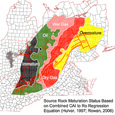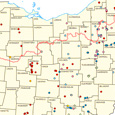Ohio’s Shale Gas Conference
Thursday, November 15, 2012

CAMBRIDGE, Ohio — Almost 100 percent of the land in Carroll County has been leased for possible Utica shale drilling, or is being held by production. That was just one of the facts shared by a team from Ohio State University Extension at the Pritchard Laughlin Civic Center auditorium Nov. 10.
The shale conversation is hot and it’s not going away anytime soon. People interested in the topic traveled from as far away as Medina County to Cambridge to hear what is going on and how it may affect them.
Chris Penrose, Ohio State University Extension educator for both agriculture and natural resources, started the conference by telling the audience it was not about pro or con of the shale drilling phenomenon, but a way to tell the public what is going on with it.
Fracking chemicals
Penrose said there have been more than 60,000 wells fracked in Ohio and over a million in the United States. Hydraulic fracturing is a process commonly used in oil development. It is a technique that cracks open rock layers to free natural gas.
Landowners and other residents typically voice concerns about the chemicals used while fracking wells.
The list of chemicals used in a Jefferson County well showed the contents contained 86 percent of water or 4.04 million gallons of water, 12.91 percent of sand and 0.4 percent of acid, according to the Ohio Department of Natural Resources.
Other chemicals listed include friction reducer, scale inhibitors, gelling, a pH agent, biocides, clay stabilizers, breakers and crosslinkers. There is less than 1 percent of these chemicals used the chemical composition used to frack wells.
Production
Another area discussed was the potential of the oil and gas production here in Ohio.
Penrose said the Utica shale has more potential than the Marcellus shale and is more extensive than the Marcellus shale in Ohio.
He also detailed production at some producing wells in Ohio.
• Buell well in Harrison County (Chesapeake Energy) has had peak rate of 9.5 mmcf (million cubic feet) gas/per day. It has also been noted to produce 1,425 bbl/s (barrels) per day of natural gas liquids or 3,010 BOE (barrels of oil equivalent) per day.
• Anadarko’s initial reports in Noble and Guernsey counties are “promising.” One well has produced 9,500 barrels of oil in 20 days.
• Gulfport Energy reported that the Shugert well in Belmont County is producing 20 mmcf gas per day or 4,914 BOE per day.
• The Frank unit well in Stark County owned by Enervest is reportedly producing 515 barrels of oil per day as of August 2012.
• Chesapeake has reported to continuously find strong production in Harrison, Columbiana and Carroll counties.
• Test wells in Ashland and Medina county are not giving high production numbers, according to Penrose, and some companies are reportedly considering pulling those exploratory wells.
Shale trends
Other interesting trends to note that were mentioned at the conference:
• Ohio has the regulatory authority of wells. Ohio regulations are equal or greater than the U.S. Environmental Protection Agency.
• All of the Marcellus shale wells fracked in the past five years in Pennsylvania, used six days of water equivalent of the Muskingum River in McConnelsville at the low water mark during the drought in June 2010, according to the Muskingum Water Conservation District.
• Exxon predicts natural gas use to surpass oil by 2030, expect a 68 percent increase between 2010 and 2020.




